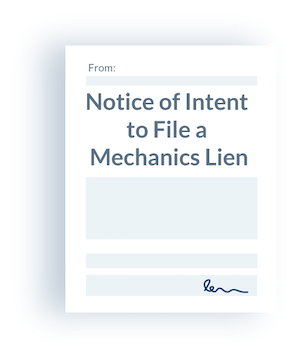
Getting paid can be more difficult that it should be on construction projects. Money changing hands through multiple parties, complex pay-apps, contractual risk-shifting clauses, workmanship disputes, and more can all result in slow payment (or even non-payment). Promoting visibility and remaining secured through preliminary notices is the first step in solving the construction payment problem, but it’s not necessarily the last step.
If payment remains slow, the urgency can be elevated by sending a notice of intent to lien. The notice of intent to lien, while rarely statutorily required, provides a useful and effective step between the preliminary notice and the actual filing of the lien claim itself. By leveraging the power of the lien claim without actually filing (yet), the notice of intent to lien can get you paid and keep the project moving, while at the same time avoiding being forced to follow through with a lien filing.
In order to be most effective, though, care should be taken to make sure the notice of intent to lien is delivered to the appropriate and relevant parties.
Who Are the Appropriate and Relevant Parties?
So, who are the appropriate and relevant parties? Once the payment issue or dispute has reached the point where the filing of a lien is contemplated, and sending a notice of intent to lien to inform the relevant parties of that fact is desired, you want to make sure that the notice of intent to lien has every opportunity to be successful in prompting payment. Accordingly, the notice of intent to lien should not only be sent to your customer, but should be sent to the parties who most want to avoid a lien claim.
This means that notices of intent to lien should always be sent to at least your customer and the property owner. The property owner has the most to lose (literally) in the even that a lien is filed (and foreclosed), and accordingly, is the party who most wants to make sure that a lien is not filed. By giving the property owner a chance to avoid his/her property being encumbered the owner can either pay or exert pressure on the responsible party to pay and everybody can avoid the time, expense, and hassle of the lien itself.
Additionally, it can be effective to send the notice of intent to lien to the general contractor, as well. There is likely a clause in the GC’s contract with the owner that the property will be kept free of liens, and the GC generally represents to the owner that the payments are being appropriately managed and tracked (and lien waivers obtained) to keep the property clear of liens. And, if the property owner is forced to pay twice for the same work because a payment didn’t make it down the chain to the claimant, you can bet they are going to look to recover from the GC. Accordingly, the GC also has a significant interest in making sure that a lien is avoided.
Finally, its important to send the notice of intent to lien to your own customer / the party that hired you (if not one of the above parties). Since this is the party that actually hasn’t paid you, and the party that will be in the crosshairs of the owner and/or GC if the lien gets filed, it’s likely that they will do everything they can to make it so the lien doesn’t get filed, since their relationship with the GC, owner, or their own hiring party can be damaged if you are forced to file a lien. Having a lien filed means that cash-management was poorly done, and that can be the difference between your hiring party being chosen for another job, or not.
Sending a notice of intent to lien can save time, save money, save relationships, and get you paid. But in order to make it work, you should be sure to send the notice to the parties that 1) control the money owed to you; and 2) have the most to lose if a lien is filed.



